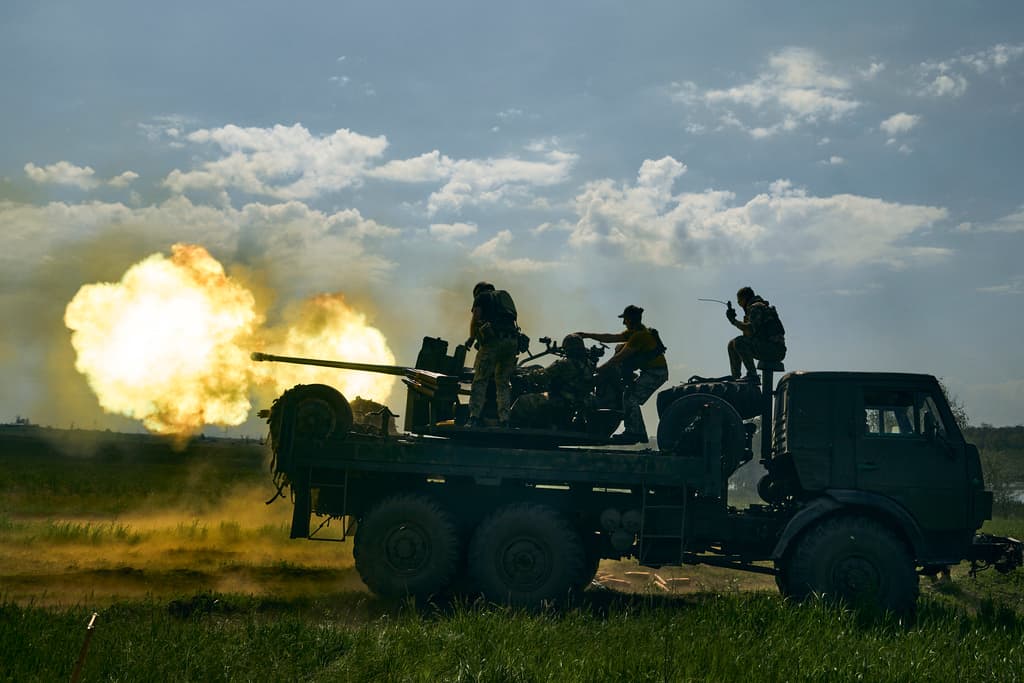Russians Are in Control of Most of Bakhmut, but Only by Destroying It
Amid parallels to Mariupol, the real Ukraine battle shapes up on the flanks.

Does anybody remember Mariupol? It’s the eastern Ukrainian city on the Black Sea coast that Russia conquered last year only by almost completely laying it to waste. About a year later, a similar fate appears to be in the cards for Bakhmut, with European and Ukrainian press reporting that the city is as much as 95 percent in Russian hands.
Yet as with Mariupol, there simply isn’t very much left of it. While Mariupol was the larger of the two cities by far, Ukraine still has the upper hand in the outskirts of Bakhmut, and that fight is far from over.
Still, the level of destruction in the strategically positioned town itself is shocking testament to months of possibly the most relentless Russian bombardment and fiercest fighting between soldiers with the Wagner mercenary group and Ukrainian defenders. Satellite images assembled by Maxar Technologies, a Colorado-based space technology firm, and published in the Daily Mail show the ghostly husks of what used to be apartment blocks, schools, and even a church and theater.
In one aerial photo dated May 15, most of the city essentially looks flattened compared to its pre-battle appearance in a photo from May of last year.
The point is that after more than eight months of fighting, Russia is on the brink of capturing what it has turned into a smoldering ghost town.
The German magazine BILD reported that Ukraine only holds one side of the westernmost street in the city and 20 buildings, or less than 1 percent of the central city’s area. It reported that Ukrainian soldiers were seen leaving the burning city, possibly trying to regroup at Ivanivske, a Ukrainian village less than two miles away.
That is also part of a crucial turn of events, because while if the notion of Bakhmut as a fortress in and of itself has expired after so much bombardment, the necessary pivot will be to holding back any Russian advance west of the ruined city. Also, if Ukraine succeeds in retaking the periphery, that would trap the Russians and not only impede their movement west but stop them from retreating to Russian-held territory to the east.
Earlier this month Ukraine’s Third Assault Brigade succeeded in capturing Russian positions west of an important canal adjacent to Bakhmut. The Wagner chief, Yevgeny Prigozhin, confirmed that one of his motorized rifle brigades had beat a retreat. According to multiple reports, though, other Wagner forces this week captured the two most heavily fortified and protected sections of the city’s walled area, pushing the Ukrainians back to the last stretch of it, which consists mostly of low-lying buildings.
Yet it is the contrast between the steady destruction of the center and more complicated, ongoing battles going on outside it that, as the the Kyiv Independent puts it, “the neverending battle for Bakhmut can now be understood almost as two separate battles.”
That’s also why Mr. Prigozhin has increasingly been harping on the Kremlin not to abandon current positions outside of Bakhmut.
In the meantime, it is not clear how the casualties stack up compared to Mariupol, though there likely have been fewer civilian losses owing to the Black Sea port city’s larger original population. Earlier this month, the national security council spokesman, John Kirby, said that in the five months leading up to May 1, Russians had suffered 100,000 casualties, including more than 20,000 dead, in the fight for Bakhmut. The Washington Post reported that 120,000 Ukrainian soldiers have been wounded or killed since the start of Russia’s invasion.
Most Ukrainian losses are where the heaviest fighting is: the Donbas, of which Bakhmut is a part (the Donetsk region specifically). According to the Kyiv Independent though, the Battle of Bakhmut is “by now likely the bloodiest single military engagement of the 21st century.”
Since President Zelensky’s visit to military positions near Bakhmut in March, the situation in the center has deteriorated but still looks promising on the flanks of the frontline. That is one reason why he is unlikely to consider any kind of negotiation for a safe exit of the Ukrainian soldiers still in Bakhmut itself. Mariupol was a different story: Negotiations undertaken there between Russia and Ukraine last year were to help evacuate civilians caught in the cross-fire.
What happens in the next several weeks in the wider Donbas is anybody’s guess. As always, when conflicts reach a critical stage, geography is key and in this part of Ukraine that means the Dnieper River. If Bakhmut falls and the Russians reach Chasiv Yar, the first city west of it, they would be in a stronger position to push the Ukrainian army back toward the Dnieper.
If that happens, it would risk splintering eastern Ukraine even more than it already is. With pressures for a counteroffensive building and Bakhmut itself slowly receding in importance, Kyiv needs to block any new Russian inroads at any cost. The forecast, at a minimum, calls for a noisy spring.

